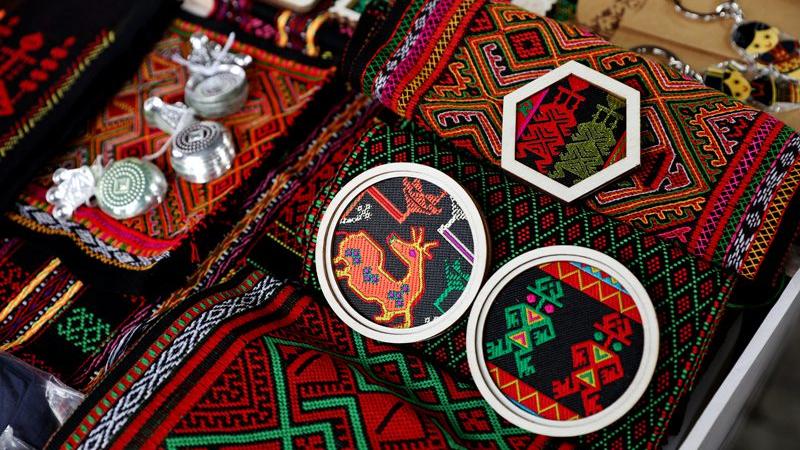Fridge magnet craze sweeps China

A woman selects cultural and creative products of a company in a shopping mall in Yuyao, east China's Zhejiang Province. (Xinhua/Xu Yu)
A total of 1 million fridge magnets featuring intricate details of the empress's phoenix coronet from the Ming Dynasty (1368—1644), a treasured piece in the National Museum of China, were sold in just eight months and six days.
"I started refreshing the webpage about half an hour early and was lucky enough to get one," said a tourist from east China's Shandong Province, who purchased the millionth fridge magnet inspired by empress's phoenix coronet on March 25, becoming a witness to the museum's record for sales of a single product or series.
Since its launch in the latter half of last year, enthusiasts have often lined up in the museum to get their hands on just one magnet.
Many other museums have also launched their innovative fridge magnets. For instance, the Beijing Ancient Architecture Museum offered a fridge magnet inspired by "Zaojing," or caisson ceiling, a kind of ceiling with distinctive feature of classical Chinese architecture.
In addition, technologies including 3D printing, three-dimensional modeling, and augmented reality (AR) have been applied to some fridge magnets.
"In recent years, fridge magnets on the market have consistently surprised me," said Hong Yunzhe, a post-2000s consumer from Shanghai, giving examples including those inspired by cultural elements like the nine-colored deer mural from the Mogao Grottoes, a UNESCO World Heritage Site in Dunhuang of northwest China's Gansu Province, and intricately crafted lattice windows from the UNESCO-listed Classical Gardens in Suzhou, east China's Jiangsu Province.
"These magnets are affordable, exquisitely crafted, and have completely changed my perception of fridge magnets," Hong said.
Since the summer of 2024, popular museums and tourist attractions have frequently seen a buying frenzy for fridge magnets. A survey by the China Tourism Academy (CTA) shows that nearly 50 percent of tourists purchase magnets priced between 20-40 yuan ($2.75-$5.5), while over 30 percent buy those in the 40-60 yuan range. Currently, the most popular cultural magnets sold offline at museums and tourist sites are priced above 40 yuan. The Beijing Ancient Architecture Museum's "Zaojing"-inspired fridge magnet costs 168 yuan, yet tourists' enthusiasm for purchasing remains high.
According to data from the Zero Power Intelligence Research Institute, China's fridge magnet market reached 3.6 billion yuan in 2020, and is expected to maintain an average annual growth rate of around 10 percent in the coming years.

A tourist from east China's Shandong Province becomes the one who purchased the millionth fridge magnet featuring intricate details of the empress's phoenix coronet from the Ming Dynasty (1368—1644), a treasured piece in the National Museum of China, on March 25. (Xinhua/Jin Liangkuai)
"I used to think fridge magnets were just 'local specialties' of tourist attractions, but now they've become pieces that young people eagerly collect to engage in social interactions," said Tan Lei, born after 1995, from Chengdu, southwest China's Sichuan Province.
Tan displayed her "fridge magnet map"—her refrigerator densely covered with magnets featuring iconic buildings from over 50 cities nationwide, each labeled with its corresponding travel date. "These magnets bring back my memories and serve as conversation topics during my social interactions," she said.
Liang Shiyong, general manager of Wenzhou Jiufu Industrial Co., Ltd., a fridge magnet manufacturer, has witnessed firsthand how the fridge magnet industry has emerged as a thriving sector.
"In 2023, we conducted market research and predicted that fridge magnets were worth a try," said Liang. The low unit price and portability of fridge magnets ultimately convinced the company to invest in a production line with a capacity of 1.2 million magnets.
"Demand upgrades and market innovation are the drivers behind the hot sales of fridge magnets," said Dai Bin, president of the CTA.
Liang believes that fridge magnets showcase strong local characteristics—each city has its own distinctive attractions, and cultural venues have unique history and artifacts. Fridge magnets featuring these elements naturally have their own distinct appeal, suggesting the market still has room for growth.
Last year, Liang's company increased investment to expand its facilities, multiplying its production capacity several times. This year, the company is projected to produce over 10 million fridge magnets. Meanwhile, he insists on producing mid-to-high end fridge magnets. "We aim to create high-quality products for sale in museums," he said.
Photos
Related Stories
- Creative cultural products facilitate development of relevant industries
- Museum's phoenix crown fridge magnet becomes unexpected cultural sensation
- Explore cultural, creative products in N China's Shanxi
- Flower-themed cultural products bloom as flowering season comes
- Chinese ethnic culture products find promising market in Italy
- China to promote development of cultural, creative products
- Chinese cultural product exports rise 16.3 pct in 2012
Copyright © 2025 People's Daily Online. All Rights Reserved.









